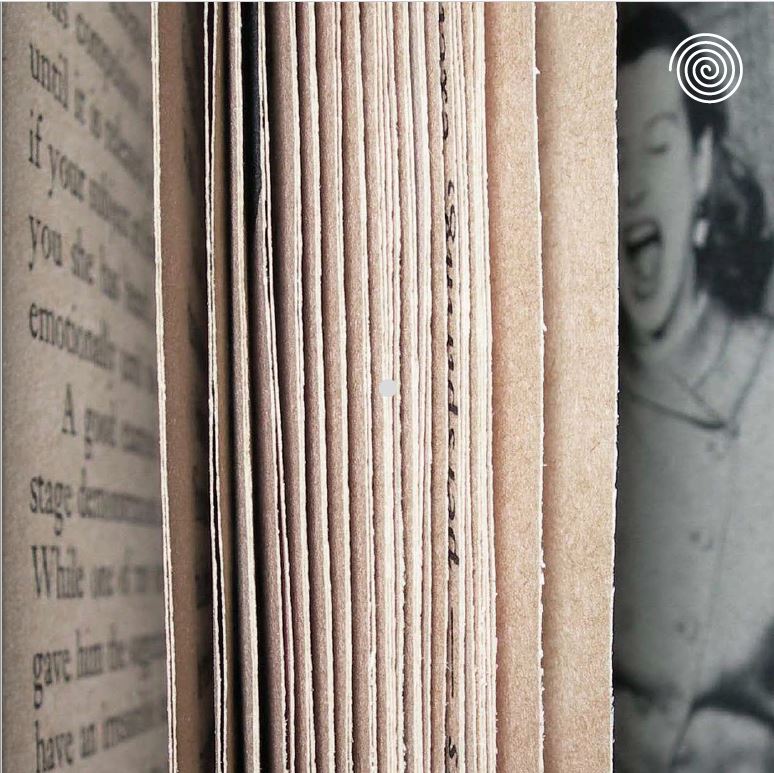The new publication Inscription: the Journal of Material Text – Theory, Practice, History opens with a self-confident and self-aggrandizing flourish. On its website https://inscriptionjournal.com and within its first two issues (mid-2020 and mid-2021) it gives us various introductions of itself.
“Journals,” it says, “work the minor miracle of being both item and series: the pearl, and the string of pearls. Here at Inscription we aim for the mobility of the seventeenth-century pamphlet, the intellectual rigour of the monograph, the walk-through-wonder of the art gallery, and that delighted dance between form and content.”

The beginning of the new journal, Inscription
Inscription looks us in the eyes, earnestly, and informs us that it is intoning the multimedia magazine Aspen (1965-71), and the Vorticist, two-issue magazine Blast (1914-15). It speaks to us with a learned lilt to tell us that it is “an exciting new publication featuring work by practitioners – book artists, printmakers and writers – alongside academic discussion. Its focus is not just on the meanings and uses of the codex book, but also the nature of writing surfaces, and the processes of mark-making in the widest possible sense: from hand-press printing to vapour trails in the sky; from engraved stones to digital text.”
And once more, with academic feeling, Inscription tells us it is “both a journal of cutting-edge research and a playful and innovative multimedia artefact.”
So how is it on the fulfillment side of this promising serial ledger?
The issues are supersized and expensive – so much so that no physical copies were made available by the journal for review. I had to depend on my MacBook Air and my iPhone, which along with iPads will be how most people access the journal. Neither of my devices provided a compelling or even a pleasant reading / viewing experience.
The opening piece of the enterprise is “On Stone,” by Serena Smith, a poetical essay on lithography that wanders back and forth through time. At play here, says Smith, is “the virtuality of duration, its tangible inscription, and the substrate of lithography stone, in an operation that brings together worlds of geology, autobiography, technology, and writing.” Smith writes with informed sensitivity about the marks made by history and hands. She’s working, after all, with objects that have the “capacity to ignite latent memory.”
In the first issue we also have an intriguing essay on epitaphs in 18th-century England by Rebecca Bullard, which documents the idiosyncratic metamorphoses that have come down to us on monuments, in manuscripts, and impressed onto paper. And there’s a searching and touching essay on skin / parchment / inscriptions by Kathryn James.
I found some of the offerings, in particular “The Work as Will: Roland Barthes Reading Group,” rather pedestrian. Not Barthes – he is seldom pedestrian, except when he wants to be – but these fleeting fragments of commentary didn’t add much to my reading or to the pages of the journal.
The first issue is printed dos-à-dos, and with each spread on a slightly different rotational axis than the previous one. The format did add to my reading experience, but only to its frustration. I’ve got perfectly serviceable electronic devices, but I have no desire to tilt my damn laptop at a different angle to read each different page.
I would suggest to the editors a bit less “look at us!” dos-à-dos cleverness, and a bit more of a musical “Do Si Do,” or at least more “do / see / do” going forward.
Inscription 2 was easier to read on a screen (no rotating text!) and had stronger graphic material, although this time we get a series of PDFs rather than a complete one (which causes its own ponderous sequential challenges).

Fionna Banner, Full Stop
Among the insightful pleasures for me in the second issue is the piece on organic and spontaneous library wormholes by Dianna Frid, Carla Nappi and Ian Truelove; the gushing, watery hole on the cover by Fionna Banner (who issued herself an ISBN in 2009 and registered herself as a publication: “a sort of self-portrait as a book,” as she says); and Christian Bök’s maelstrom soundscapes “The Oracle at the End of Time” and “Afterthoughts in the Void.”
I was prepared to make use of Inscription to get closer to Carolyn Thompson’s piece “The Beast in Me,” but I was unable to capture it from the Inscription website. I did eventually find the piece on Thompson’s own website, and its circular, tumultuous love is certainly worth a wider audience.
Some of the concerns I had with Inscription 1 are still evident in number 2. Co-editor Gill Partington introduces Erica Baum’s artwork “Piano Rolls” with the words “strange and compelling,” “subtle reconstruction that seems to elicit new possibilities of meaning,” and “an enigmatic kind of visual poetry.” I like Baum’s work, but do I need my hand held by Partington quite so firmly, quite so insistently, quite so helpfully? Please: let the work read and be and show itself.
Of passing interest to me was “Cigar Burn Apertures” by David Bellingham. I was intrigued that he describes at some length his art-making talents, but does not reference Antonin Artaud’s crazed, cigarette-burnt magic spells.

Carolyn Thompson, The Beast in Me (detail)
One thing about Aspen: the contents of the gathered pieces complemented the forms in which they were presented. There was engagement and wit and newness and playfulness. I would be delighted for Inscription to meet or at least approach its own lofty ambitions. No thematic topic has yet been mentioned for issue number 3, which will begin to take shape in early 2022. Here’s a suggestion: “Show, Don’t Tell.”
Peter O’Brien edited the journal Rubicon, which included interviews with Margaret Atwood and Mavis Gallant, poems by Eavan Boland, and artwork by Ann Hamilton. His books include Cleopatra at the Breakfast Table (about studying Latin with his daughter) and Dream Visions: The Art of Alanis Obomsawin, published in 2021 by Viggo Mortensen / Perceval Press.

